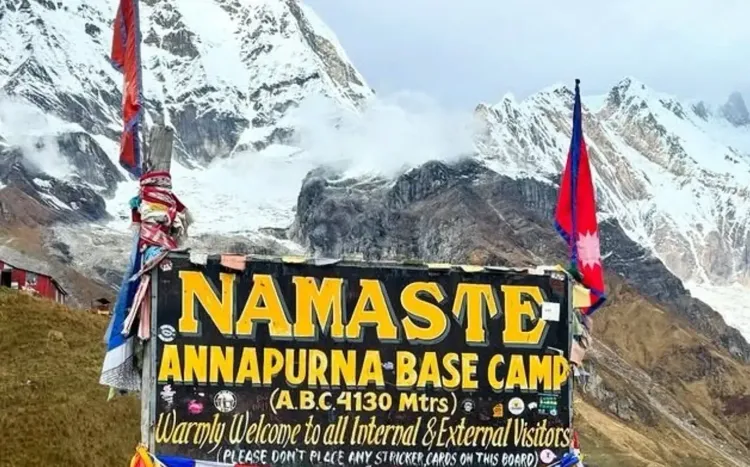Why Has Nepal Stopped Access to Annapurna Base Camp?

Synopsis
Key Takeaways
- Access to Annapurna Base Camp is restricted until October 31.
- Recent snowfall poses safety risks for trekkers.
- Authorities are conducting rescue operations for stranded individuals.
- Weather forecasts indicate more snowfall and rain in the coming days.
- Travelers are urged to stay informed and exercise caution.
Kathmandu, Oct 28 (NationPress) The local authorities in Nepal's Myagdi district, situated in western Nepal, have prohibited access to the renowned tourist attraction—Annapurna Base Camp (ABC)—until October 31 due to recent snowfall, which poses a significant risk to the safety of trekkers.
The District Administration Office (DAO) of Myagdi announced that this decision was made following reports of snowfall in the ABC region, with expectations of further snowfall in the high, hilly, and mountainous areas of the district, endangering both residents and trekkers.
October marks the peak trekking season in Nepal, drawing a considerable number of adventurers to the mountainous regions, including ABC.
“As of Tuesday evening, over a dozen individuals who had reached ABC have not been heard from,” stated Senior Superintendent of Police Tul Bahadur Karki, spokesperson at the Gandaki Province Police Office, in an interview with IANS.
“We remain uncertain about their safety, given the lack of communication.”
Nonetheless, a police representative from the Myagdi District Police Office reported that they have no information regarding any distress at ABC.
“Individuals are making their way back, and we have stationed police personnel to assist them should any issues arise,” the official stated.
Recently, the Department of Hydrology and Meteorology has forecasted snowfall across the high, hilly, and mountainous areas of western Nepal, including the ABC region.
This weather change is attributed to the influence of Cyclone ‘Mountha’, which has formed over the Bay of Bengal.
In the meantime, the Armed Police Force (APF) disclosed that hundreds of individuals stranded due to snowfall in various mountainous districts have been rescued and relocated to safe zones by a collaborative effort involving the Nepal Army, Armed Police Force, and Nepal Police.
A total of 750 people stranded by snow were safely transported from Tilicho Base Camp in Manang—a western mountainous district—to the Khangsar area, while an additional 50 individuals found refuge at Tilicho Base Camp itself.
“Due to limited accommodation and food resources in Khangsar for the influx of tourists visiting Manang, arrangements were made to ensure the safe return of some tourists,” stated the APF.
Furthermore, the Department of Hydrology and Meteorology warned that snowfall and rainfall could affect central and eastern regions of Nepal from October 30 to November 1.
Various government agencies in Nepal are urging the public to exercise caution when traveling through the high, hilly, and mountainous regions.
The Nepal Tourism Board (NTB) has advised all mountaineering and trekking teams, as well as both domestic and international tourists, to remain vigilant in light of the adverse weather conditions expected in the coming days.
The board has issued alerts regarding heavy rain, snowfall, and potential flooding across numerous districts, including Gorkha, Manang, Mustang, Myagdi, Nawalpur, Kaski, Parbat, Dolpa, Humla, Rasuwa, Nuwakot, Dhading, Lamjung, Jumla, Mugu, Kalikot, Dailekh, Jajarkot, Salyan, Rukum (East and West), Baglung, Surkhet, Banke, and Bardiya.
In addition, the National Disaster Risk Reduction and Management Authority (NDRRMA) has reiterated its advice to avoid travel unless absolutely necessary and has recommended that residents in flood-prone areas relocate to safer locations when needed.
“Individuals residing along riverbanks in potentially affected regions should stay alert and move to safer areas if threats are observed,” the authority advised. “Do not leave paddy or other crops unharvested; if harvested, store them securely without delay.”









